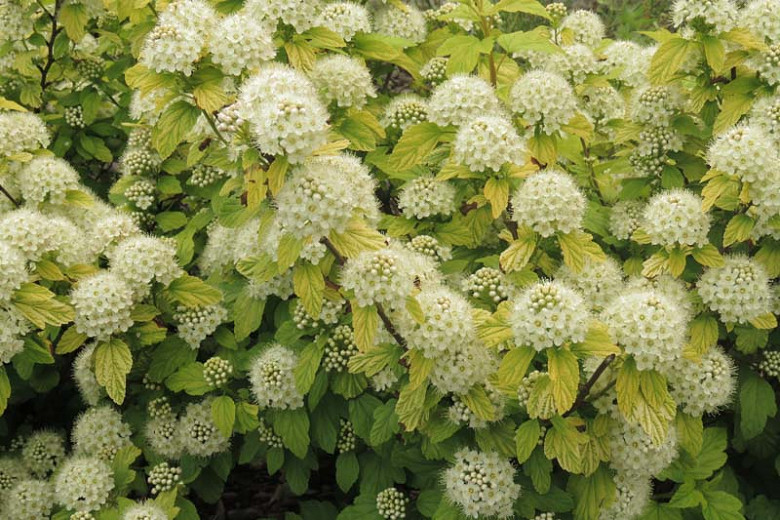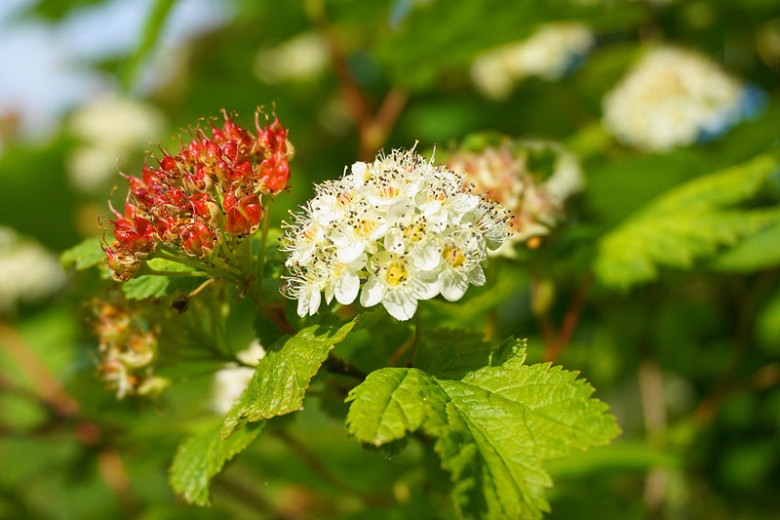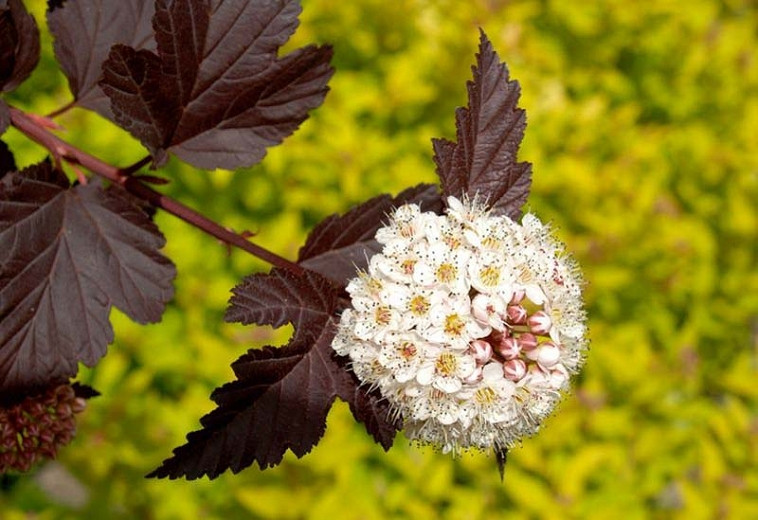Physocarpus opulifolius (Common Ninebark)
Physocarpus opulifolius (Common Ninebark) is a fast-growing, upright, spreading, deciduous shrub with an exquisite fountain shape and incredibly decorative exfoliating bark. Profuse creamy-white flowers, delicately pink-tinged, appear in dense, rounded clusters in late spring before they give way to drooping clusters of red fruit in fall. Rich in nectar, the blossoms attract plenty of beneficial insects. The flowers contrast beautifully with the interesting maple-like foliage of green lobed leaves, which turns yellow in the fall. Hidden by the foliage during the growing season, the bark is revealed in all its splendor later in the season, peeling in multiple strips to display layers of reddish to light brown inner bark, providing winter interest. Known for its strong hardiness, insect and disease resistance, and drought tolerance, Common Ninebark is a splendid screening and hedge plant.
- Grows up to 5-8 ft. tall (150-240 cm) and 4-6 ft. wide (120-180 cm).
- This plant is easily grown in full sun to part shade in average, slightly acidic, dry to medium moisture, well-drained soils. Best bloom display occurs in full sun but appreciates some afternoon shade in hot summer areas. Tolerates a wide range of soil conditions, including dry soil and clay soil. Common Ninebark does not enjoy hot and humid summer climates. Drought tolerant.
- Perfect as a specimen plant or planted in groups. Great for mixed shrub borders, hedges, and screens or for banks and slopes (erosion control).
- No serious pest or disease issues. Keep an eye out for fireblight and leaf spots.
- May be cut back to the ground in winter to rejuvenate.
- Propagate by fall-sown seed or semi-hardwood cuttings.
- Prune as required immediately after bloom
- Native to central and eastern North America.
Requirements
| Hardiness | 2 – 8 |
|---|---|
| Heat Zones | 1 – 10 |
| Climate Zones | 1, 1A, 1B, 2, 2A, 2B, 3, 3A, 3B, 4, 5, 6, 7, 8, 9, 10, 14, 15, 16, 17, A1, A2, A3 |
| Plant Type | Shrubs |
| Plant Family | Physocarpus – Ninebark |
| Exposure | Full Sun, Partial Sun |
| Season of Interest | Spring (Late)Summer (Early,Late)Fall |
| Height | 5' – 8' (150cm – 240cm) |
| Spread | 4' – 6' (120cm – 180cm) |
| Spacing | 48″ – 72″ (120cm – 180cm) |
| Water Needs | Low, Average |
| Maintenance | Low |
| Soil Type | Clay, Loam, Sand |
| Soil pH | Acid, Neutral |
| Soil Drainage | Moist but Well-Drained, Well-Drained |
| Characteristics | Showy |
| Native Plants | United States, Midwest, Illinois, Indiana, Iowa, Kansas, Michigan, Minnesota, Missouri, Nebraska, North Dakota, Ohio, South Dakota, Wisconsin, Northeast, Connecticut, Delaware, Maine, Massachusetts, Maryland, New Hampshire, New Jersey, New York, Pennsylvania, Rhode Island, Vermont, Rocky Mountains, Colorado, Southeast, Alabama, Arkansas, Florida, Georgia, Kentucky, North Carolina, South Carolina, Tennessee, Virginia, West Virginia, Southwest, Oklahoma |
| Tolerance | Clay Soil, Drought, Dry Soil, Rocky Soil, Wet Soil |
| Attracts | Birds |
| Garden Uses | Banks and Slopes, Beds and Borders, Hedges and Screens |
| Garden Styles | Informal and Cottage, Traditional Garden |


